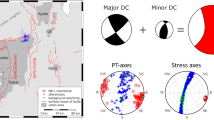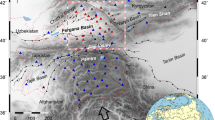Abstract
The 29 May 2017 Mw 6.6 Poso earthquake occurred in the eastern part of Central Sulawesi with a normal faulting mechanism, which is the largest normal earthquake to have occurred in the region since instrumental records have been available. Approximately 400 aftershocks were well-recorded by the Indonesian Agency for Meteorology, Climatology, and Geophysics' (BMKG) broadband seismic network for 1 month after the mainshock. Here, we obtain the source parameters of the Mw 6.6 mainshock by using moment tensor inversion on seismic data that came from 14 stations within a radius of 7° from the mainshock epicenter. It results in the best point-source solution of 103°, 56°, and −100° for the strike, dip, and rake, respectively, and a centroid depth of 6.4 km. The kinematic solution shows a unilateral rupture process with an average slip of ~ 0.5 m on a 20-km rupture length. The source mechanism indicates the extension behavior in the eastern part of Central Sulawesi and the northward mass extrusion process that occurred in the area during the Quaternary. Based on the seismic source parameters and geomorphologic analysis, we propose the Tokorondo Fault as being responsible for the earthquake. A total of 361 aftershock hypocenters are successfully relocated using the double-difference method and indicate three clusters of the off-fault aftershocks. We calculate the Coulomb failure stress (CFS) changes to investigate the occurrence of these aftershocks. The result indicates that the off-fault aftershocks have mostly occurred within the increased CFS change area with a value > 0.1 bar.







Similar content being viewed by others

References
Badan Nasional Penanggulangan Bencana (BNPB). (2017). Tanggap Darurat Gempa Poso. https://bnpb.go.id/berita/tanggap-darurat-gempa-poso-selama-7-hari-ratusan-rumah-rusak. Accessed 11 Mar 2021.
Bellier, O., Sébrier, M., Seward, D., Beaudouin, T., Villeneuve, M., & Putranto, E. (2006). Fission track and fault kinematics analyses for new insight into the Late Cenozoic tectonic regime changes in West-Central Sulawesi (Indonesia). Tectonophysics, 413(3–4), 201–220.
Cesca, S., Heimann, S., Stammler, K., & Dahm, T. (2010). Automated procedure for point and kinematic source inversion at regional distances. Journal of Geophysical Research: Solid Earth, 115, B6.
Cesca, S., Braun, T., Maccaferri, F., Passarelli, L., Rivalta, E., & Dahm, T. (2013). Source modelling of the M5–6 Emilia-Romagna, Italy, earthquakes (2012 May 20–29). Geophysical Journal International, 193, 1658–1672.
Geller, R. J. (1976). Scaling relations for earthquake source parameters and magnitudes. Bulletin of the Seismological Society of America, 66(5), 1501–1523.
Gulia, L., Rinaldi, A. P., Tormann, T., Vannucci, G., Enescu, B., & Wiemer, S. (2018). The effect of a mainshock on the size distribution of the aftershocks. Geophysical Research Letters, 45(24), 13–277.
Hall, R. (2002). Cenozoic geological and plate tectonic evolution of SE Asia and the SW Pacific: Computer-based reconstructions, model and animations. Journal of Asian Earth Sciences, 20(4), 353–431.
Hall, R. (2011). Australia–SE Asia collision: Plate tectonics and crustal flow. Geological Society, London, Special Publications, 355(1), 75–109.
Hall, R., & Sevastjanova, I. (2012). Australian crust in Indonesia. Australian Journal of Earth Sciences, 59(6), 827–844.
Heidarzadeh, M., Muhari, A., & Wijanarto, A. B. (2019). Insights on the source of the 28 September 2018 Sulawesi tsunami, Indonesia based on spectral analyses and numerical simulations. Pure and Applied Geophysics, 176(1), 25–43.
Heimann, S. (2011). A robust method to estimate kinematic earthquake source parameters, PhD thesis, University of Hamburg, Hamburg, Germany.
Kennett, B. L. N., & Engdahl, E. R. (1991). Traveltimes for global earthquake location and phase identification. Geophysical Journal International, 105(2), 429–465.
King, G. C. P., Stein, R. S., & Lin, J. (1994). Static stress changes and the triggering of earthquakes. Bulletin of the Seismological Society of America, 84, 935–953.
Lin, J., & Stein, R. S. (2004). Stress triggering in thrust and subduction earthquakes and stress interaction between the southern San Andreas and nearby thrust and strike-slip faults. Journal of Geophysical Research: Solid Earth, 109, B2.
Petruccelli, A., Schorlemmer, D., Tormann, T., Rinaldi, A. P., Wiemer, S., Gasperini, P., & Vannucci, G. (2019). The influence of faulting style on the size-distribution of global earthquakes. Earth and Planetary Science Letters, 527, 115791.
Silver, E. A., McCaffrey, R., & Smith, R. B. (1983). Collision, rotation, and the initiation of subduction in the evolution of Sulawesi, Indonesia. Journal of Geophysical Research: Solid Earth, 88(B11), 9407–9418.
Socquet, A., Simons, W., Vigny, C., McCaffrey, R., Subarya, C., Sarsito, D., Ambrosius, B., & Spakman, W. (2006). Microblock rotations and fault coupling in SE Asia triple junction (Sulawesi, Indonesia) from GPS and earthquake slip vector data. Journal of Geophysical Research: Solid Earth, 111, B8.
Spencer, J. E. (2010). Structural analysis of three extensional detachment faults with data from the 2000 Space-Shuttle Radar Topography Mission. Geological Society of America, 20, 4–10.
Spencer, J. E. (2011). Gently dipping normal faults identified with Space Shuttle radar topography data in central Sulawesi, Indonesia, and some implications for fault mechanics. Earth and Planetary Science Letters, 308(3–4), 267–276.
Toda, S., Stein, R. S., Sevilgen, V. and Lin, J. (2011). Coulomb 3.3 Graphic-rich deformation and stress-change software for earthquake, tectonic, and volcano research and teaching—user guide: U.S. Geological Survey Open-File Report 2011–1060, 63 p. https://pubs.usgs.gov/of/2011/1060/.
Vigny, C., Perfettini, H., Walpersdorf, A., Lemoine, A., Simons, W., van Loon, D., Ambrosius, B., Stevens, C., McCaffrey, R., Morgan, P., & Bock, Y. (2002). Migration of seismicity and earthquake interactions monitored by GPS in SE Asia triple junction: Sulawesi, Indonesia. Journal of Geophysical Research: Solid Earth, 107(10), 7.
Waldhauser, F. (2001). hypoDD–A program to compute double-difference hypocenter locations (hypoDD version 1.0–03/2001). US Geological Survey Open File Report, 1, 113.
Waldhauser, F., & Ellsworth, W. L. (2000). A double-difference earthquake location algorithm: Method and application to the Northern Hayward Fault, California. Bulletin of the Seismological Society of America, 90, 1353–1368.
Wang, S., Xu, C., Xu, W., Yin, Z., Wen, Y., & Jiang, G. (2019). The 2017 Mw 6.6 Poso Earthquake: Implications for extrusion tectonics in Central Sulawesi. Seismological Research Letters, 90(2A), 649–658.
Watkinson, I. M., & Hall, R. (2017). Fault systems of the eastern Indonesian triple junction: Evaluation of Quaternary activity and implications for seismic hazards. Geological Society of London, Special Publications, 441(1), 71–120.
Wessel, P., Smith, W. H., Scharroo, R., Luis, J., & Wobbe, F. (2013). Generic mapping tools: Improved version released. Eos, Transactions American Geophysical Union, 94(45), 409–410.
Acknowledgements
The authors are grateful to the two anonymous reviewers whose comments have helped to improve the manuscript. The regional seismic waveforms are retrieved from the Indonesian Agency for Meteorology Climatology and Geophysics (BMKG), upon request. All figures were created using the Generic Mapping Tools (Wessel et al., 2013). We are thankful to Sebastian Heimann, Simone Cesca, and Lars Krieger for the Rapidinv code and the pre-calculated Kiwi Tools Green’s function database. This research was supported by the Indonesia Endowment Fund for Education (LPDP), Ministry of Finance of the Republic of Indonesia, under grant no. KET-3476/LPDP.4/2020.
Author information
Authors and Affiliations
Corresponding author
Ethics declarations
Conflict of interest
The authors have no conflict of interest.
Additional information
Publisher's Note
Springer Nature remains neutral with regard to jurisdictional claims in published maps and institutional affiliations.
Rights and permissions
About this article
Cite this article
Daniarsyad, G., Sianipar, D., Heryandoko, N. et al. Source Mechanism of the 29 May 2017 Mw 6.6 Poso (Sulawesi, Indonesia) Earthquake and Its Seismotectonic Implication. Pure Appl. Geophys. 178, 2807–2819 (2021). https://doi.org/10.1007/s00024-021-02779-y
Received:
Revised:
Accepted:
Published:
Issue Date:
DOI: https://doi.org/10.1007/s00024-021-02779-y



